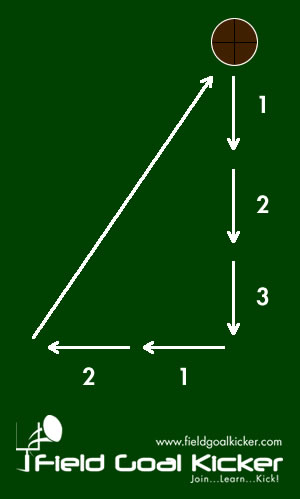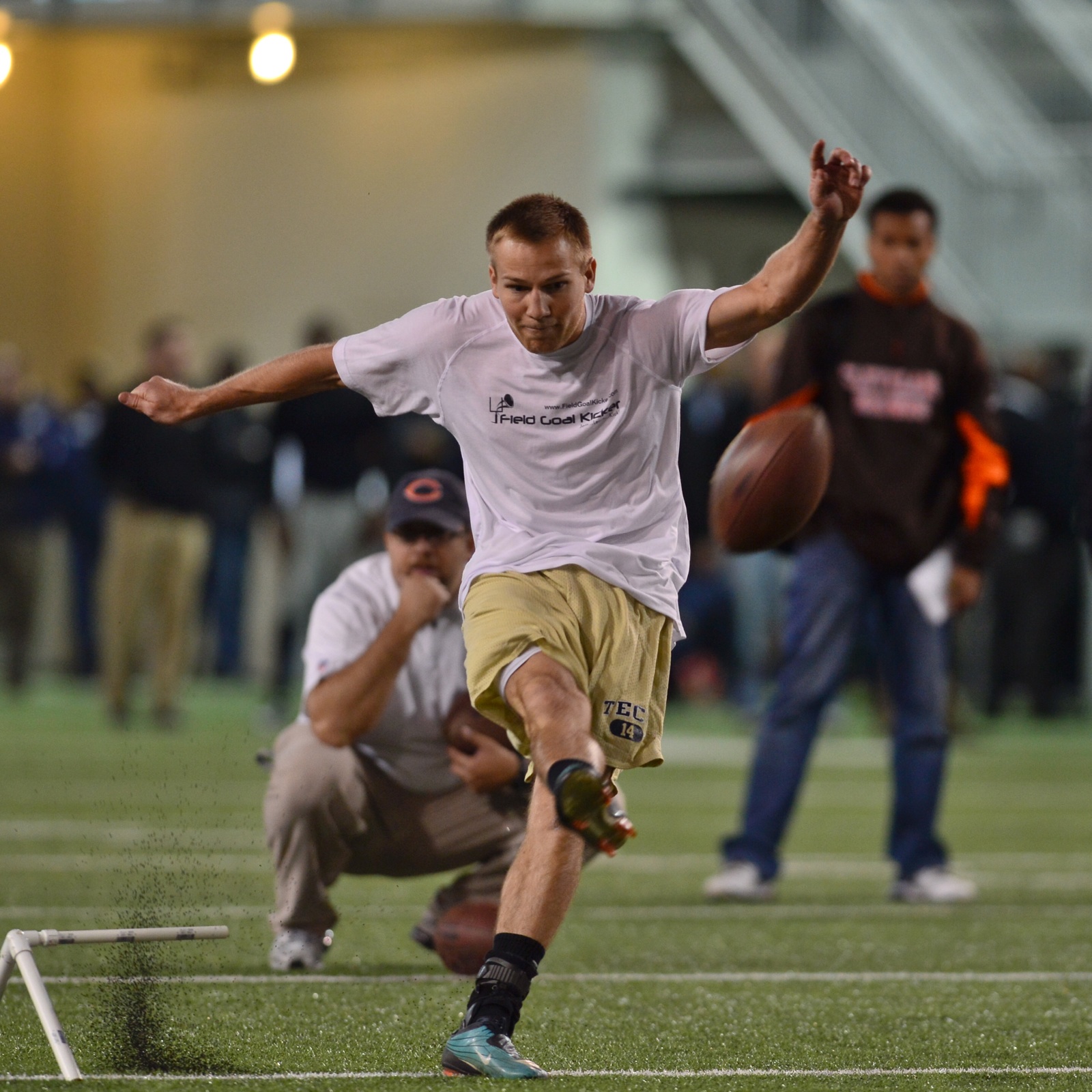How To Kick A Football
 I learned how to kick a football in the eighth grade when my soccer coach, who conveniently was the football coach as well, asked me to come out to kick some field goals.
I learned how to kick a football in the eighth grade when my soccer coach, who conveniently was the football coach as well, asked me to come out to kick some field goals.
I had played soccer since I was four years old. I thought to myself “how hard can it actually be to learn how to kick a football?”
I learned very quickly that kicking is not as easy as it looks, even with a soccer background.
You will find a lot of people that say, “I can kick a 40-yard field…it’s easy to learn how to kick a football.” After dealing with enough of these guys I found out they are telling the truth, at least partially.
At ONE point along the way, they kicked a 30-yard field goal and now they think it’s easy. The hard part comes from making those kicks consistently.
I Want To Learn How To Kick A Football!
Every kicker has a different kicking style to some degree, but the fundamentals remain true throughout the best kickers today. Breaking technique down into sections of how to kick a football come in a few broad but fundamental phases we call approach, contact, and finish.
How To Kick A Football Step 1: Setting Up for “Soccer Style”
The first, and most important aspect of learning how to kick a football is how we ‘approach’ the football and make proper contact. Which part of the foot are you kicking with exactly again?
 Approach? What do you mean? Well, we all begin kicking as preschoolers by running straight at a kick ball for instance, then kicking with the front toe of our shoe. We don’t see straight on kickers anymore though for good reason.
Approach? What do you mean? Well, we all begin kicking as preschoolers by running straight at a kick ball for instance, then kicking with the front toe of our shoe. We don’t see straight on kickers anymore though for good reason.
In today’s soccer style place kicking world, that seems like an obvious answer. However, there are still TONS of kids who begin kicking the football with their toe.
It’s not as bad as you think…they don’t kick from ‘straight on’ as those old school kickers did many years ago.
However, the modified style is still what we refer to generally as ‘kicking with the toe’, and it’s one of the first things we have to change with many young kickers.
We call this the side winder toe ball kicker because at a young age he’s seen kickers on TV taking ‘steps’, generally 3 back and 2 to the side.
 So, the kicker is actually approaching the ball from the right location for a soccer style kick, but he’s not actually making contact with the proper part of the kicking foot.
So, the kicker is actually approaching the ball from the right location for a soccer style kick, but he’s not actually making contact with the proper part of the kicking foot.
For most young kids just getting started, the toe ball feels (though incorrect) like the optimal place to strike a football.
I can’t tell you how many father’s we see at lessons and clinics who say “my son is already kicking soccer style” when in reality, he only ‘looks’ like he’s kicking that way.
Aside from the angle of our approach, we need to consider the distance we cover in getting there.
Too far back, and not only will we likely have to lunge for the ball (throwing our balance and consistency) but we run the risk of getting every kick blocked! The typical distance for a soccer style kicker is about 3 comfortable steps back from the ball, and two comfortable steps to the side.
This will form something of an imaginary triangle on the ground.
How To Kick A Football Step 2: Contact & The Soccer Style Kick
So, we’ve established that we must approach the ball from the side rather than from straight on. We do this because the surface area of the instep is larger than the tip of the toe, resulting in more consistent kicks.
 However, if you cannot make solid contact with the correct part of the football with your foot, there is no point in learning the rest of the fundamentals…yet.
However, if you cannot make solid contact with the correct part of the football with your foot, there is no point in learning the rest of the fundamentals…yet.
Making that proper contact comes from turning your foot “down and out.” The toe should actually NEVER make contact with the football…it’s our instep (the Navicular bone on the top of the foot) that is the contact point!
Picture your kicking foot like a putter in golf, but turned slightly forward.
The goal is to kick the football about 2 inches below center with the Navicular bone on the top of your foot. At all points throughout the kick, you must keep your foot and ankle locked.
We won’t get into the details of what we call ‘swing path’ in this post, these are the very basics. Make no mistake however, that once a kicker is comfortable with a smooth approach and consistent contact, learning to maximize your swing path (think about a big back swing in golf) will result in longer, more consistent kicks.
How To Kick A Football Step 3: The Big Finish
 Regardless of how huge smooth and controlled the approach is, how explosive back swing is, how consistent the contact is (matching sweet spots on both the foot AND the ball), the finish (including the follow through) can help most any kicker trouble shoot every other phase of his kick.
Regardless of how huge smooth and controlled the approach is, how explosive back swing is, how consistent the contact is (matching sweet spots on both the foot AND the ball), the finish (including the follow through) can help most any kicker trouble shoot every other phase of his kick.
One of the most wildly inconsistent phases of kicking that we see is indeed the finish. Most kickers look slightly different on almost every kick when it comes to the finish, and we feel that this is a mistake.
Having a finish that is first off in the right place (about 1 step out, 1 step over for most), and in the correct direction (moving toward your target, not away from it), is very similar to what we see with top golfers. How often do you see a golfer finishing a swing that looks completely different from shot to shot? Hardly ever, at least among the best in the world.
The quick advise, PAY ATTENTION TO YOUR FINISH. It should be the same nearly every time (unless you are kicking in poor weather conditions or adjusting for poor footing of course).
Once you have put all of the physical parts of the kick together, the trick to learning how to kick a football at the next level or winning the starting spot is doing it consistently.
You have to practice in consistently to be able to kick consistently. This means taking the same steps each time (an inch shorter or longer can mess effect your entire kick), taking the same approach to the ball, contacting the ball the at the same spot on the ball and your foot, and following through to your target the same way every time.
This is not an easy thing to replicate, and you must make each practice kick count! The more ‘robotic’ you can make your approach, contact and finish each and every time, the more consistency you’ll see from your kicks.
Sound as easy as you thought? Trust me, it’s harder than most people think. For more detailed information, other tips, tricks, and drills become an FGK Member as we try to help you win the job and play at the next level.
